* This article has been translated with a translation tool.

The simplest way I've found to explain how our show recommendation system works is to draw a parallel with the game: BattleshipThis game, which first saw the light of day in 1930 with a paper version, and was popularized by Milton Bradley from 1967 onwards, is a strategy game that has stood the test of time. The aim is simple: find your opponent's ships before he finds yours.
Although this board game may at first appear to rely solely on luck, mathematics and in-depth analysis have shown that humans often act in similar ways. For example, in Rock, Paper, Chisel, It's the rock that comes out first. Similarly, you are more likely to find your target in the center of the grid at the Battleship.
We use this same predisposition that people have to target the right shows in our suggestions. Think of the database we use as a gigantic table, where the rows are people and the columns are shows. For each person, we start with the number 0 in each box. When a person makes a purchase, we replace the 0 in that box with a 1. Then, when that same person fills in the satisfaction survey, we subtract or add 1 to the number already entered for that show.
We then take a second person and fill in the table in the same way. Then repeat the operation over and over again, until every customer in the network has completed his or her grid line.
If you want to " find the boat " of our enemy, or in our case the right show for a customer, then we'll look at what this customer, let's call him Mr Y, has bought and enjoyed. We'll then analyze all the people who have made purchases and who have had similar experiences to those of Mr Y. Among these people, we'll take those who have several behavioral similarities with our customer. We'll see which shows these people have bought and enjoyed, and which have not already been bought by Mr Y. We'll then suggest the shows from this list that come up most often. Finally, we'll assess his interest in these suggestions.
Obviously, I've simplified the concept a lot to make it understandable. However, we have a target we don't know, as in Battleship. We use experience and statistics to find this target, and if we play well, we win! The big difference is that in our case, victory is shared by all. The presenter sells more tickets, the artist has a good audience and the customer is offered a show he should be happy with.
If you'd like us to go into more depth on the subject, please let us know and we can plan a follow-up to this article or a more substantial document.
Thanks and talk to you soon,
![]()
Jonathan Roy
Customer Experience Manager

